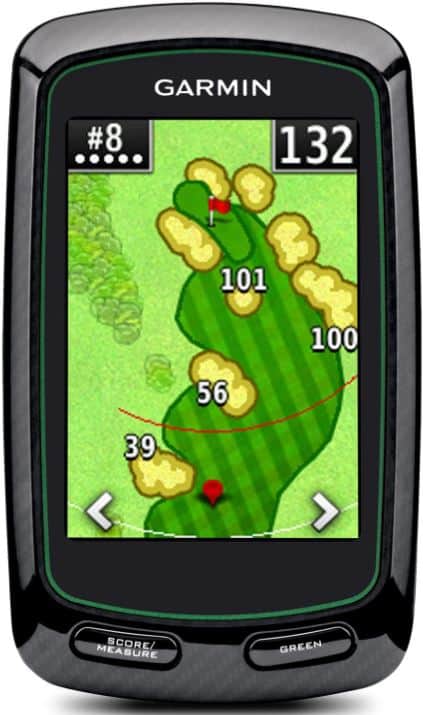The Garmin G80 handheld device is Garmin’s newest handheld golf GPS. It was released in January 2019. The Garmin Approach G80 has many improvements over the Garmin G8. The Garmin G80 has a bigger display area and better display resolution than the G8. Also the Garmin G80 has more accurate distances to hazards and flags than the G8 and only the Garmin G80 has a radar-based launch monitor for measuring the ball speed, clubhead speed and carry distance. However, the Garmin G80 is not as good as the best launch radars on the market, including the Swing Caddie SC300, Mevo, and Rapsodo. The Garmin G80 and SC300 measure clubhead speed and ball speed but only the SC300 measures spin rate.
The golf launch monitor is the best feature of Garmin G80 handheld. This is the first time a Garmin handheld contained both a GPS and launch monitor in one unit. The launch monitor uses the radar (which is an acronym radio detection and ranging) in the Garmin G80. There are a multitude of benefits to using a golf launch monitor including measuring ball flight and club data after ball impact.
Unfortunately, the Garmin G80’s launch monitor is not as sophisticated as the dedicated launch monitors from Swing Caddie, Flightscope and Rapsodo. This means that the Garmin G80 does not measure or calculate as much ball flight and club data as the more sophisticated dedicated launch monitors can including total spin and launch angle. The ball flight and club data that the Garmin G80 can measure or calculate are listed below.
Ball Speed
The ball speed is the measurement of the golf ball’s velocity right after it leaves the club face. The average male golfer can achieve a ball speed of at least 130 mph.
The ball speed is determined by the club head speed and angle of approach to the ball. Hooking or slicing the ball can reduce the ball speed. The speed of the golf ball after impact is the most important factor in getting a lot of distance with your shots.
Club Head Speed
The club head speed is a measure of how fast the head of the golf club travels right before the club makes contact with the golf ball. The average club head speed of an amateur golfer is about 95 mph which translates to a ball distance of over 200 yards. Since club head speed is directly proportional to the power of a golf swing, anything that increases club head speed also increases the power of a golfer’s swing. For example, if the swing speed of the golfer increases by 10 mph, the resulting golf swing should generate approximately 10% more club head speed.
One method to increase swing speed is improving your follow through by keeping your arm and hand in the same position throughout the swing and extending your arms fully after hitting the ball so that you can transfer all of the energy from your clubhead into the ball.
Keep your wrist bent and elbow close to your body to keep your hips in line with your spine and ensure power is transferred from the backswing into the forward swing.
Practice keeping a consistent tempo throughout your swing by maintaining a 3:1 ratio between your backswing and downswing. Too often golfers start to slow down or speed up mid-swing, which can lead to poor results on the golf course.
Carry Distance and Total Shot Distance
The Garmin G80 can only use ball speed and club head speed to estimate the carry distance and total shot distance. The very best launch monitors use ball speed, spin of the golf ball, and launch angle of the ball to determine the golf ball’s carry and total distance which will give you more accurate information.
The Garmin G80 can give you a more accurate total shot distance by adjusting the roll factor, which is meant to compensate for the device’s inability to measure the ball spin and launch angle.
More backspin on a ball will give it a higher launch angle and stop the ball faster on the green. Low spinning balls have lower launch angles than balls with a lot of backspin but they travel straighter, and as a result, further.
Smash Factor
The smash factor is the speed of the golf ball after impact divided by the speed of the clubhead after impact. The smash factor will tell you how efficient you are at hitting the ball. The higher the smash factor, the more energy is being applied to the ball. If you swing a club that has a smash factor of 0.90, then he will apply 90% of the energy from your swing to the ball.


